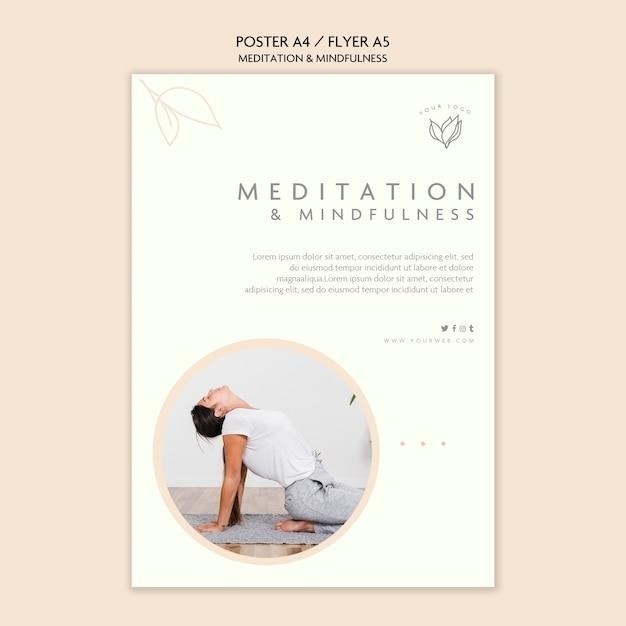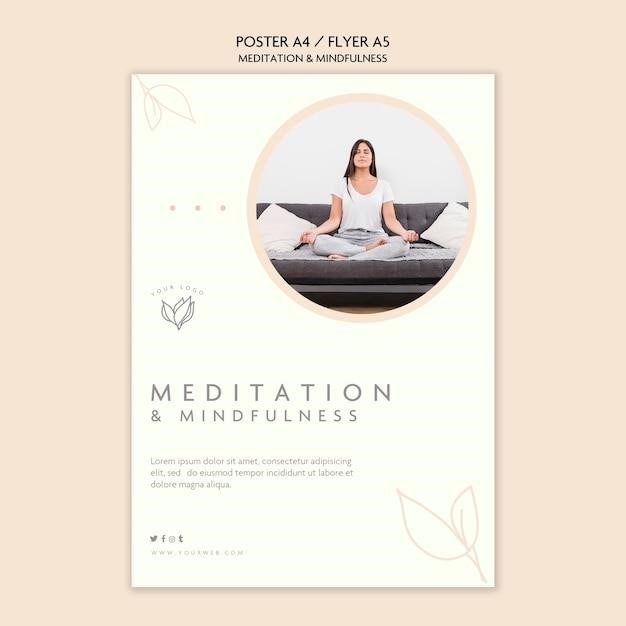20-minute guided meditation script pdf

20-minute guided meditation script pdf
Finding Free 20-Minute Guided Meditation Scripts in PDF
Numerous websites offer free downloadable 20-minute guided meditation scripts in PDF format. These readily available resources provide convenient self-guided sessions for both beginners and experienced practitioners seeking mindfulness.
Benefits of Guided Meditations
Guided meditations, especially those lasting 20 minutes, offer numerous benefits for mental and emotional well-being. They provide a structured approach to mindfulness, leading to reduced stress and anxiety. The clear instructions help beginners cultivate focus and presence, while experienced practitioners can deepen their practice. Regular use can improve sleep quality, enhance self-awareness, and foster a sense of calm and inner peace. A 20-minute session fits easily into daily routines, making it sustainable for long-term benefits. The guided nature of the practice helps navigate the process, reducing the challenges of self-directed meditation. The combination of audio and written scripts caters to different learning styles, making this a versatile tool for self-improvement.
Locating Free PDF Scripts Online
Finding free 20-minute guided meditation scripts in PDF format is surprisingly easy. Many websites dedicated to mindfulness and meditation offer these resources for download. A simple online search using keywords like “free guided meditation scripts PDF” or “20-minute meditation script PDF” will yield numerous results. Reputable sources often provide scripts focusing on various themes, such as stress reduction, gratitude, or self-compassion. Always check the credibility of the website before downloading to ensure the content aligns with your needs and expectations. Blogs, wellness platforms, and even some meditation app websites may provide direct links or embedded PDFs. Remember to explore diverse sources to find a script style and voice that resonates best with you.
Using Scripts for Beginners and Experienced Practitioners
Free 20-minute guided meditation scripts in PDF format are beneficial for both novice and experienced meditators. Beginners can use the structured guidance to learn proper techniques and build a consistent practice, overcoming initial challenges. The clear instructions and pacing provide a supportive framework for establishing a comfortable routine. Experienced practitioners can utilize these scripts to explore new themes or techniques, deepen their existing practice, or simply enjoy a convenient and readily available session. The scripts often include elements such as body scans, breathwork exercises, or visualizations, adaptable to different experience levels. Even seasoned practitioners may find value in the structure and focus a script provides, facilitating a more profound meditative experience.
Creating Your Own Guided Meditation Script
Crafting a personalized 20-minute guided meditation script allows for tailored themes and techniques, enhancing the meditative experience. Explore your creativity and inner wisdom to guide others or yourself.
Structuring a 20-Minute Script
A well-structured 20-minute guided meditation script typically begins with a brief introduction, setting the tone and intention. This is followed by a body comprising several stages, each focusing on a specific aspect of mindfulness, such as breath awareness, body scan, or visualization. These stages might involve guided imagery, positive affirmations, or mindful movement prompts. Transitions between stages should be smooth and natural, using calming language. The middle section should be the longest, allowing ample time for deep relaxation and exploration. The script concludes with a gentle return to awareness, offering closing thoughts or suggestions for integrating the meditation into daily life. A clear and concise structure ensures a coherent and effective practice. Remember to keep the pacing appropriate for your audience.
Choosing Appropriate Language and Tone
The language used in a 20-minute guided meditation script significantly impacts its effectiveness. Opt for calm, soothing words, avoiding jargon or overly complex sentences. A gentle, reassuring tone fosters trust and encourages relaxation. Use inclusive language that resonates with a broad audience, avoiding potentially triggering phrases. Consider incorporating metaphors and imagery to enhance the listener’s experience, painting vivid mental pictures that promote a sense of peace. The tone should be consistent throughout, maintaining a feeling of safety and guidance. Remember, the goal is to create a tranquil atmosphere conducive to deep relaxation and mindful awareness, so choose your words carefully to achieve this effect.
Incorporating Mindfulness Techniques
Effectively incorporating mindfulness techniques is crucial for a successful 20-minute guided meditation script. Begin by guiding the listener to focus on their breath, a cornerstone of mindfulness practice. Encourage them to observe the sensations of each inhale and exhale without judgment. Next, introduce body scans, prompting awareness of physical sensations throughout the body. Gently guide attention to different parts, noting any tension or discomfort without trying to change them. Incorporate loving-kindness meditations, focusing on self-compassion and extending positive feelings to others. Mindful awareness of sounds and sights in the environment can also be included, encouraging non-reactive observation. Remember to emphasize the importance of returning to the breath when the mind wanders, a natural part of the process.

Best Practices for Writing Effective Scripts
Craft clear, concise narratives promoting calmness and relaxation. Use open-ended language for personal interpretation, ensuring a gentle, guiding tone throughout the 20-minute session.
Clear and Concise Narrative
A well-structured 20-minute guided meditation script necessitates a clear and concise narrative. Avoid overly complex sentence structures or jargon; prioritize simple, easily understood language that flows naturally. The script should guide the listener effortlessly through each stage of the meditation, ensuring a smooth and coherent experience. Each instruction should be brief and unambiguous, allowing for effortless comprehension and minimizing potential distractions. Transitions between different phases of the meditation, such as body scans or visualizations, should be seamless and logically connected to maintain the flow and prevent cognitive dissonance. The narrative should have a beginning, middle, and end, creating a satisfying and complete meditative journey. A clear and concise narrative is crucial for both novice and experienced meditators, contributing significantly to the effectiveness of the meditation practice.
Promoting Calmness and Relaxation
The language used in a 20-minute guided meditation script is paramount in fostering calmness and relaxation. Employing a gentle, soothing tone is essential; avoid words or phrases that might induce anxiety or tension. The pace of the narration should be slow and deliberate, allowing ample time for listeners to absorb each instruction and fully immerse themselves in the meditative experience. Incorporate calming imagery and metaphors, such as flowing water, gentle breezes, or peaceful landscapes, to evoke feelings of serenity and tranquility. The overall tone should be reassuring and supportive, creating a safe and comfortable space for the listener to release stress and tension. Careful attention to vocabulary and vocal delivery can significantly enhance the relaxation response and overall effectiveness of the meditation.
Open-Ended Language for Personal Interpretation
Effective 20-minute guided meditation scripts utilize open-ended language to encourage personal interpretation and individual experiences. Instead of prescribing specific feelings or visualizations, the script should offer suggestions and prompts that allow the listener to connect with their own inner world. Using phrases like “notice what arises” or “allow yourself to feel” empowers the individual to personalize the meditation. Avoid rigid instructions that might restrict the natural flow of thoughts and feelings. The goal is to create a flexible framework that adapts to each listener’s unique experience, fostering a sense of self-discovery and mindful exploration within the meditation. This approach enhances the sense of personal agency and makes the meditation more meaningful and engaging for each individual.

Example Guided Meditation Themes
Explore themes like stress reduction, self-compassion, and gratitude. These common focuses offer readily adaptable frameworks for 20-minute guided meditations.
Mindfulness for Anxiety and Stress Reduction
A 20-minute guided meditation focusing on mindfulness can be a powerful tool for managing anxiety and stress. Scripts often begin by guiding the listener to find a comfortable position, focusing on the breath as an anchor to the present moment. The meditation may incorporate body scans, encouraging awareness of physical sensations without judgment. Gentle prompts might encourage the release of tension held in the body. Positive affirmations and visualizations of calm, peaceful scenes can further enhance the experience. The script’s pace should be slow and soothing, allowing ample time for each instruction. The concluding section usually guides a gradual return to full awareness, leaving the listener feeling grounded and centered, ready to approach their day with increased calmness and resilience. Many free resources offer such scripts online in PDF format.
Cultivating Self-Compassion
Guided meditations designed to cultivate self-compassion often begin by inviting the listener to acknowledge their inner critic and any self-judgmental thoughts. The script might then guide the practitioner to recognize their own suffering and the universality of human experience, emphasizing that everyone faces challenges and imperfections. A key element is the practice of extending kindness and understanding towards oneself, as one would towards a dear friend facing similar struggles. This may involve repeating positive affirmations or visualizing a comforting and supportive presence. The meditation might encourage the listener to identify their strengths and positive qualities, fostering a sense of self-acceptance and appreciation. The concluding section often reinforces the importance of self-compassion as an ongoing practice, rather than a one-time event. Free 20-minute scripts focusing on this are available online in PDF format.
Gratitude Meditation
A 20-minute gratitude meditation script typically starts by guiding the listener into a relaxed state, perhaps through deep breathing exercises or body scans. The focus then shifts to prompting reflection on aspects of life for which one feels grateful. This could involve recalling specific events, relationships, or personal qualities. The script might encourage a detailed sensory exploration of these experiences, enhancing the emotional impact of the gratitude. The practice often involves expressing gratitude verbally, either aloud or silently, reinforcing the positive feelings. Some scripts incorporate visualizations, such as imagining the source of gratitude as a warm light or a comforting presence. The closing section often involves extending feelings of gratitude outwards to others and setting an intention to carry this appreciative mindset into daily life. Many free PDF scripts are readily available online.